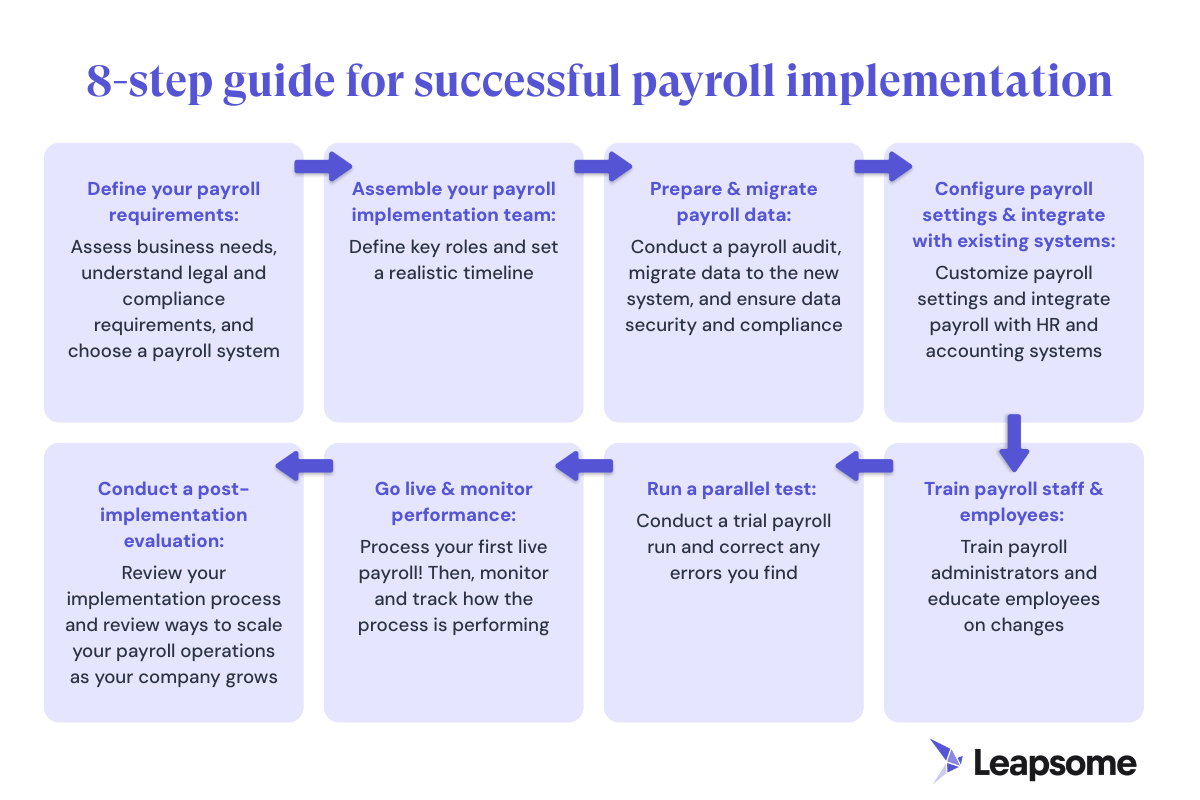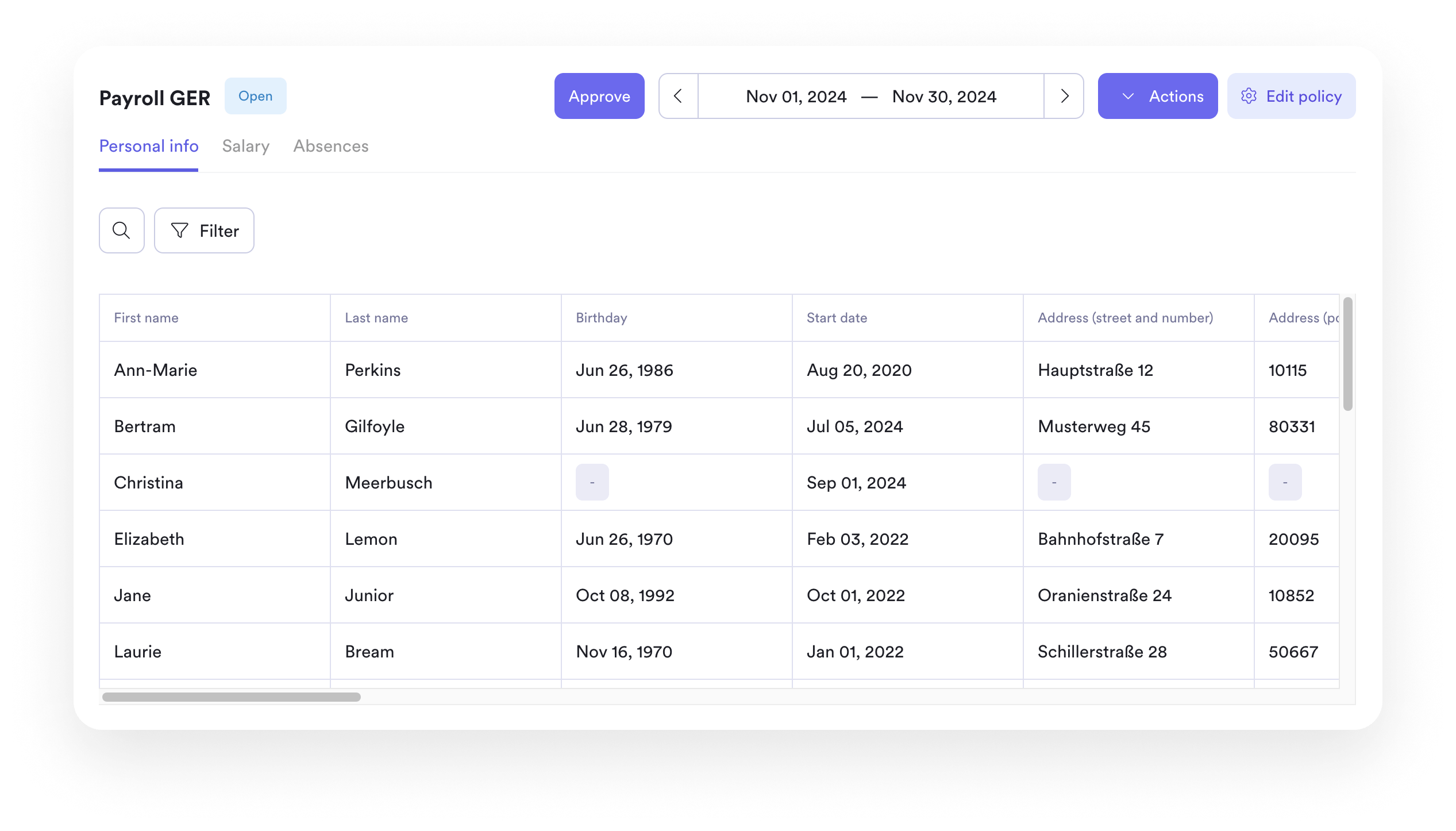Der ultimative Leitfaden für die Implementierung der Gehaltsabrechnung
.jpg)
Vier von zehn Mitarbeitern geben an, dass sie in den letzten 12 Monaten einen Fehler bei der Gehaltsabrechnung beheben mussten, wobei 18% drei oder mehr davon hatten solche Fehler während dieser Zeit. *
Die Personalabteilung trägt die Verantwortung für die Beseitigung dieser Fehler, insbesondere da Burnout und steigende Arbeitsbelastung immer häufiger auftreten. Über 60% der Mitarbeiter, die mitarbeiten, berichten von einer höheren Arbeitsbelastung, und eine unzureichende Bezahlung ist nach wie vor einer der Hauptgründe für Fluktuation.
Auch HR-Teams sind nicht davor gefeit: 74% sind der Meinung, dass sie heute mehr technische Fähigkeiten benötigen als noch vor Kurzen.** Und das ist kein Wunder. Die Implementierung der Gehaltsabrechnung ist neben vielen anderen wichtigen HR-Prozessen aufgrund der wachsenden technischen Stacks, der Datenanforderungen und der verteilten Teams komplexer geworden.
In diesem Umfeld kann sich der Einstieg in ein neues Gehaltsabrechnungssystem überwältigend anfühlen. Mit dem richtigen Ansatz kann die Implementierung der Gehaltsabrechnung jedoch ein Kinderspiel sein. In diesem Leitfaden beschreiben wir, wie Sie einen erfolgreichen Gehaltsabrechnungsprozess implementieren und sich von Fehlern bei der Gehaltsabrechnung verabschieden können.
🕊️ Einfache Vorbereitung der Gehaltsabrechnung
Leapsome erleichtert die Gehaltsabrechnung und hilft Ihnen dabei, automatisch Zyklen zu starten, Daten zu importieren/exportieren und Berichte zu erstellen.
👉 Erfahre mehr
*Fernbedienung, 2024
**Bericht „Leapsome Workforce Trends“, 2024
8-stufiger Leitfaden für eine erfolgreiche Implementierung der Gehaltsabrechnung
Wir haben den Implementierungsprozess für die Gehaltsabrechnung in acht einfache Schritte unterteilt. Obwohl diese Schritte am besten der Reihe nach befolgt werden, können Sie einige im Laufe der Zeit noch einmal überprüfen, wenn Sie Ihre Gehaltsabrechnung optimieren.

1. Definieren Sie Ihre Gehaltsabrechnungsanforderungen
Analysieren Sie zunächst die Bedürfnisse Ihres Unternehmens und erstellen Sie ein ideales Anbieterprofil. Wenn Sie dies im Voraus tun, erhöht sich die Wahrscheinlichkeit einer erfolgreichen Implementierung.
Berücksichtigen Sie alle folgenden Punkte:
- Größe der Belegschaft — Wie viele Mitarbeiter beschäftigen Sie?
- Steuerliche Verpflichtungen — Welche Gesetze und Vorschriften zur Gehaltsabrechnung müssen Sie einhalten? Wir empfehlen, diesbezüglich einen Anwalt zu konsultieren, falls Sie dies noch nicht getan haben.
- Mitarbeiterklassifizierungen — Wie viele Teammitglieder arbeiten in Vollzeit oder in Teilzeit oder sind befreit oder nicht ausgenommen (in den USA)? Beschäftigen Sie Saisonarbeiter oder Auftragnehmer?
- Wachstumspläne — Planen Sie, in den nächsten Jahren nach oben oder unten zu skalieren?
- Notwendige Funktionen — Welche Funktionen sind ein Muss für Ihr Gehaltsabrechnungssystem? Sind KI und Automatisierungen wichtige Ergänzungen zu Ihrem Arbeitsablauf?
Die Absicht dieser Übung geht über die Vorbereitung einer reibungslosen Umsetzung hinaus. Sie sollten diese Gelegenheit auch nutzen, um Lücken in Ihrer aktuellen Gehaltsabrechnungsstrategie zu identifizieren und sich Gedanken darüber zu machen, wie der richtige Anbieter Ihnen helfen könnte. Beispielsweise finden Sie möglicherweise Redundanzen in Ihrem aktuellen HR-Tech-Stack. Wenn das der Fall ist, ein Personalinformationssystem (HRIS) mit Gehaltsabrechnungsfunktionen wie Leapsome ist dies möglicherweise die beste Wahl.
🤔 Neu im Gehaltsabrechnungsjargon? Schauen Sie sich unsere an Glossar der Begriffe der Gehaltsabrechnung für klare Erklärungen!
2. Stellen Sie Ihr Team für die Implementierung der Gehaltsabrechnung zusammen
Eine erfolgreiche Implementierung des Gehaltsabrechnungssystems erfordert Teamarbeit. Bringen Sie also frühzeitig die wichtigsten internen Stakeholder zusammen, um sich abzustimmen, Verantwortlichkeiten aufzuteilen und Vertrauen aufzubauen. Ein typisches Team für die Implementierung der Gehaltsabrechnung könnte Folgendes umfassen:
- Personal- und Gehaltsabrechnungsspezialisten zu verwalten Mitarbeiterdaten, Aufzeichnungen, und Leistungen
- Finanz- und Buchhaltungsfachleute um die Einhaltung der Steuervorschriften und die Berichterstattung zu gewährleisten
- Vertreter des IT-Teams um eine sichere Datenmigration und Systemintegration zu gewährleisten
- Leiter des Betriebsteams um das Projekt zu verwalten und gültige Zeitpläne festzulegen
Das genaue Team, mit dem Sie zusammenarbeiten werden, hängt natürlich von den Besonderheiten Ihres Unternehmens ab. Beispielsweise können kleine Unternehmen auch den Gründer oder CEO in diesen Prozess einbeziehen. Stellen Sie unabhängig von der spezifischen Zusammensetzung Ihres Teams sicher, dass Sie und andere interne Stakeholder wichtige Meilensteine für die Softwareauswahl, Datenvalidierung und Tests festlegen. Planen Sie, Ihre Mitarbeiter frühzeitig zu schulen und Ihr System vor der ersten offiziellen Gehaltsabrechnung zu testen.
3. Gehaltsabrechnungsdaten vorbereiten und migrieren
Führen Sie vor der Migration der Gehaltsabrechnungsdaten eine gründliche Prüfung durch, um die Mitarbeiterdaten zu überprüfen — einschließlich Namen, Adressen, Steuerstatus und Gehälter. Das Entfernen veralteter oder doppelter Datensätze hilft dabei, die Datengenauigkeit aufrechtzuerhalten und Ihr System auf einen reibungslosen Übergang vorzubereiten.
Dies ist ein guter Schritt, um über Automatisierung nachzudenken. Manuelle Dateneingabe und Migration sind riskant, insbesondere in einem aufzeichnungsintensiven Bereich wie der Gehaltsabrechnung, wo einfache Unstimmigkeiten in den Mitarbeiterdaten zu verspäteten Gehaltsabrechnungen und sogar zu Compliance-Problemen führen können.
💬 „Sich in einer Welt der Automatisierung auf die manuelle Dateneingabe zu verlassen, ist so, als würde man eine Schreibmaschine einem Laptop vorziehen. Die Gehaltsabrechnungstechnologie wurde weiterentwickelt, um menschliche Fehler zu minimieren, Prozesse zu rationalisieren und Genauigkeit im großen Maßstab zu gewährleisten. Dennoch wehren sich einige Unternehmen immer noch gegen Veränderungen und halten an veralteten Methoden fest, die die Genauigkeit der Gehaltsabrechnung gefährden.“
— Ian Giles, Direktor von Ian Giles Consulting
Überprüfen Sie während dieses Schritts unbedingt die Einhaltung von Datenschutzgesetzen wie dem Allgemeine Datenschutzverordnung (GDPR) und die Gesetz zur Portabilität und Rechenschaftspflicht von Krankenversicherungen (HIPAA).
4. Konfigurieren Sie die Gehaltsabrechnungseinstellungen und integrieren Sie sie in bestehende Systeme
Als nächstes ist es Zeit zu bestimmen, was Gehaltsabrechnungszyklus Ihr Unternehmen wird dies verfolgen und Steuerabzüge, Vergünstigungen und direkte Einzahlungsoptionen einrichten.
Sie sollten jetzt auch den Integrationsprozess starten. Stellen Sie sicher, dass Ihr Gehaltsabrechnungsanbieter eine nahtlose Verbindung zu Ihrem herstellt Zeiterfassung, Leistungsmanagement- und Buchhaltungssoftware oder ermöglicht zumindest schnelle und einfache Importe/Exporte von Excel-Dateien. Besser noch, erwägen Sie die Einführung eines umfassenden Tools, das zwei oder mehr dieser Funktionen nativ bietet.
5. Schulung von Gehaltsabrechnungspersonal und Mitarbeitern
Gehaltsabrechnungsadministratoren benötigen eine solide Schulung zur Funktionsweise des Systems, zur Berechnung der Steuern und zur Behebung von Fehlern. Erwägen Sie, einen Leitfaden zur Fehlerbehebung zu erstellen, der diese häufig gestellten Fragen beantwortet und Panik in letzter Minute verhindert.
Entwickeln Sie auf ähnliche Weise Kommunikationsmaterialien für Ihr gesamtes Team, in denen Sie Anleitungen zu neuen Funktionen bieten (z. B. Erläuterungen zur Verwendung von Self-Service-Portalen und zum Zugriff auf Gehaltsabrechnungen und Steuerformulare). Anpassbare, KI-gestützte Lösungen wie Leapsome Lernen kann in diesem Schritt sehr hilfreich sein.
Neben dem Onboarding sollten Sie Ihren neuen Gehaltsabrechnungsprozess dokumentieren. Erstellen Sie Standardarbeitsanweisungen (SOPs) für die Bearbeitung von Aufgaben im Zusammenhang mit der Gehaltsabrechnung mit dem neuen System und sorgen Sie für klare Eskalationswege bei Streitfällen oder Problemen.
🏃 Bringen Sie Ihre Leute auf den neuesten Stand
Starten Sie mit Leapsome Learning anpassbare Onboarding-Pfade und maßgeschneiderte Gehaltsabrechnungstrainings.
👉 Entdecken Sie unsere L&D-Lösung
6. Führen Sie einen parallelen Testlauf durch
Sobald Sie die Integrationsphase abgeschlossen haben, starten Sie einen Test-Gehaltsabrechnungszyklus, um Fehler zu beheben und anhaltende Fehler zu identifizieren und zu beheben. Bei diesem Prozess wird die Leistung Ihres neuen Gehaltsabrechnungssystems mit der Ihres alten verglichen.
Beurteilen Sie die Ergebnisse und beheben Sie etwaige Unstimmigkeiten. Achten Sie insbesondere auf Fehlkalkulationen, falsche Steuerabzüge oder fehlende Mitarbeiterdaten, da Sie aufgrund dieser Versäumnisse möglicherweise Unannehmlichkeiten machen müssen Gehaltsabrechnung außerhalb des Zyklus läuft die Linie runter.
7. Gehen Sie live mit der Gehaltsabrechnung und überwachen Sie die Leistung
Herzlichen Glückwunsch, Sie haben es zu Ihrer ersten offiziellen Gehaltsabrechnung geschafft! Sie sollten trotzdem nach kurzfristigen Problemen suchen und sicherstellen, dass alle Zahlungen die Mitarbeiter korrekt erreichen. Drücken Sie jedoch die Daumen, dass all Ihre gründlichen Tests Sie auf einen reibungslosen ersten Gehaltsabrechnungszyklus vorbereitet haben.
Jetzt ist es an der Zeit, die Genauigkeit der Gehaltsabrechnung, die Einhaltung der Steuervorschriften und die Pünktlichkeit zu überwachen. Wenn etwas nicht stimmt, sprechen Sie es sofort an. Automatisieren Sie routinemäßige Abrechnungsaufgaben wo möglich, und passen Sie die Arbeitsabläufe an die Entwicklung Ihres Unternehmens an, um einen effizienten Ablauf zu gewährleisten.
8. Führen Sie nach der Implementierung eine Bewertung durch
Der letzte Schritt zur Implementierung der Gehaltsabrechnung erfordert eine kontinuierliche Teamüberwachung. Im Wesentlichen müssen Sie die Leistung Ihres Systems konsequent überwachen. Ein guter Anfang ist eine Überprüfung Gehaltsabrechnungen um Genauigkeit und Effizienz zu gewährleisten und Engpässe oder wiederkehrende Probleme zu identifizieren.
Sie müssen auch über die Gehaltsbestimmungen auf dem Laufenden bleiben. Überwachen Sie Änderungen der Steuergesetze und Compliance-Anforderungen und passen Sie Ihre Gehaltsabrechnungsrichtlinien entsprechend an.
Stellen Sie sich schließlich der Herausforderung, die Genauigkeit kontinuierlich zu verbessern und Ihren Gehaltsabrechnungsprozess im Laufe der Zeit weiter zu beschleunigen. Nachverfolgung und Berichterstattung über Kennzahlen zur Gehaltsabrechnung kann hier helfen. Es ist auch von Vorteil, erweiterte Funktionen wie die KI-gestützte Gehaltsabrechnungsautomatisierung zu verwenden, wodurch die Zeit reduziert wird, die Sie mit der manuellen Überprüfung von Berichten und der Initiierung der Gehaltsabrechnung verbringen müssen.
„Die Art der Daten (strukturiert oder unstrukturiert), mit denen Sie arbeiten, ist ein wichtiger Faktor bei der Entscheidung [ob generative KI verwendet werden soll]. Die andere ist die Ausgabe, die Sie benötigen. Ich ermutige mein Publikum, Schritt für Schritt vorzugehen: Können Sie das Problem mit RPA lösen? * Mach das zuerst. Wenn nicht, können Sie es mit herkömmlicher KI lösen? Benutze das.“
— Anita Lettink, Personal- und Gehaltsabrechnungsberater
*RPA (Robotic Process Automation) ist eine Software, die sich wiederholende, regelbasierte Aufgaben automatisiert, indem sie menschliche Handlungen in digitalen Systemen nachahmt. Sie funktioniert anwendungsübergreifend und erledigt Dinge wie Dateneingabe, Dateiübertragungen und Formularverarbeitung.
😵 💫 Wir wissen — das waren eine Menge Informationen!
Aber wenn du suchst ein noch gründlicheres Aufschluss darüber, wie Sie die Gehaltsabrechnung gesetzeskonform abwickeln können. Erwägen Sie, unsere kostenlose Checkliste für die Gehaltsabrechnung.
Optimieren Sie die Implementierung der Gehaltsabrechnung mit Leapsome

Wenn Sie den richtigen Payroll-Anbieter wählen und einen soliden Implementierungsprozess einrichten — wie den in diesem Leitfaden beschriebenen — Ihr System ist in kürzester Zeit betriebsbereit.
Das Geheimnis unserer Time-to-Value? Unser preisgekröntes Kundenservice-Team und umfassende Schulungsressourcen. Unsere CS-Experten setzen sich dafür ein, dass Sie Folgendes implementieren Lohn- und Gehaltsabrechnung (und unsere anderen HR- und Personalförderungslösungen) erfolgreich und effizient.
👋 Verabschieden Sie sich von frustrierenden Gehaltsabrechnungen
Der benutzerfreundliche Ansatz von Leapsome bei der Gehaltsabrechnung und anderen HR-Kernaufgaben, bei dem der Mensch an erster Stelle steht, ermöglicht es Ihnen, Ihre beste Arbeit ohne Stress zu leisten.
👉 Eine Demo buchen
Häufig gestellte Fragen zur Implementierung der Gehaltsabrechnung
Was ist die Implementierung der Gehaltsabrechnung?
Implementierung der Gehaltsabrechnung beschreibt den Prozess der Auswahl und Integration eines neuen Gehaltsabrechnungssystem in Ihren aktuellen Arbeitsablauf. Dies kann ein komplexer Prozess sein, der eine ehrliche und häufige Kommunikation mit externen und internen Stakeholdern erfordert — einschließlich Ihres Gehaltsabrechnungsdienstleisters sowie Ihrer Kollegen aus den Bereichen Finanzen und Betrieb. Mit der richtigen Anleitung und Plattform können Sie jedoch in wenigen Wochen mit der erfolgreichen Bearbeitung der Gehaltsabrechnung beginnen.
Warum ist die Implementierung einer Gehaltsabrechnungssoftware wichtig?
Die Implementierung einer Gehaltsabrechnungssoftware ist wichtig, da eine ordnungsgemäße Einrichtung sicherstellt, dass Ihre Systeme problemlos zusammenarbeiten. Mit anderen Worten, eine erfolgreiche Implementierung der Gehaltsabrechnung kann den Unterschied zwischen einem schwerfälligen, fehleranfälligen System und einem reibungslosen „Einrichten und Vergessen“ -Prozess ausmachen. Genau dafür wurde die Lohn- und Gehaltsabrechnungssoftware schließlich entwickelt: Sie trägt dazu bei, manuelle Fehler zu reduzieren, zeitaufwändige Aufgaben zu erleichtern und es Personalfachleuten zu ermöglichen, sich auf wertvollere Aufgaben zu konzentrieren.
Was sind einige Best Practices für die Implementierung der Gehaltsabrechnung?
Zu den wichtigsten Best Practices für die Implementierung der Gehaltsabrechnung gehören:
- Proaktive Kommunikation mit Stakeholdern — Viele interne Teams sind am Implementierungsprozess der Gehaltsabrechnung beteiligt (z. B. Personal, Finanzen, Betrieb und Projektmanagement). Richten Sie frühzeitig starke Kommunikationswege mit diesen Teams ein und stellen Sie sicher, dass Sie die gesamte Zustimmung der Teams für die Software Ihrer Wahl haben. Bestimmen Sie für jede Abteilung einen Ansprechpartner, um die Kommunikation zu erleichtern und Vertrauen effektiver aufzubauen. Extern sollten Sie auch eine enge Beziehung zum Kundendienstmitarbeiter Ihres Lohnabrechnungsanbieters aufbauen.
- Mitarbeiter früh und häufig schulen — Informiere dein Team so schnell wie möglich über erwartete Änderungen. Sie werden Fragen dazu haben, wie sich Ihr neues Gehaltsabrechnungssystem auf ihre tägliche Arbeit auswirken wird. Seien Sie also bereit, diese Fragen im Voraus zu beantworten. Sie sollten auch Zeit für die Schulung der Mitarbeiter im neuen Gehaltsabrechnungssystem einplanen.
- Auswahl des richtigen Gehaltsabrechnungsdienstleisters — Wählen Sie einen Anbieter mit vielen positiven Bewertungen von Kollegen. Bewertung Geschichten von Kunden auf ihrer Website, um die Time-to-Value zu verstehen und zu erfahren, wie sie fortlaufenden Support bieten werden. Am wichtigsten ist, dass Sie ihre Angebote überprüfen und sicherstellen, dass sie den Wachstumsplänen Ihres Unternehmens entsprechen. Schließlich werden Sie den Implementierungsprozess nicht so schnell wieder aufnehmen wollen.
Benötigen Sie eine Schulung für die Implementierung der Gehaltsabrechnung?
Ja, Sie benötigen eine Schulung für die Implementierung der Gehaltsabrechnung. Diese Materialien werden jedoch in der Regel von Ihrem Gehaltsabrechnungsanbieter bereitgestellt. Er sollte über eine Bibliothek mit Schulungsressourcen für Sie verfügen und im Idealfall während Ihrer gesamten beruflichen Beziehung zur Verfügung stehen, um weitere Fragen zu beantworten.
Sie müssen auch Ihre Mitarbeiter schulen, damit sie vollständig verstehen, wie das neue Gehaltsabrechnungssystem funktioniert. Ein guter Anbieter kann Ihnen auch diesbezüglich eine Anleitung geben.
Was sind die häufigsten Herausforderungen bei der Implementierung der Gehaltsabrechnung?
Zu den häufigsten Herausforderungen bei der Implementierung der Gehaltsabrechnung gehören:
- Einhaltung der Vorschriften — Welche spezifischen Gesetze und Vorschriften für Sie gelten, hängt davon ab, wo Ihr Unternehmen tätig ist und wo Ihre Mitarbeiter leben. Es kann eine Herausforderung sein, sich über regulatorische Änderungen im Klaren zu sein und die Einhaltung der Vorschriften zu gewährleisten, insbesondere für Unternehmen, die in mehreren Ländern tätig sind und verteilt oder vollständig tätig sind Teams an entfernten Standorten.
- Integration mit anderen Systemen — Gehaltsabrechnungssysteme ohne robuste Integrationsfunktionen können schwierig in Ihren aktuellen Arbeitsablauf zu integrieren sein. Wenn Ihre Mitarbeiterdaten und Gehaltsabrechnungen beispielsweise isoliert sind, ist die Wahrscheinlichkeit, dass Sie mit kostspieligen Zahlungsfehlern konfrontiert werden, höher. Aus diesem Grund wenden sich viele HR-Teams an HRIS-Plattformen oder andere umfassende HR-Systeme um Gehaltsabrechnungen zu verarbeiten und wichtige Mitarbeiterdaten zu hosten
.
- Initiierung des Änderungsmanagements — Je nachdem, wie gut Ihr Gehaltsabrechnungssystem integriert ist, kann auch das Änderungsmanagement problematisch werden. Viele Fachkräfte bevorzugen die Verwendung eines oder einiger ausgewählter HR-Tools. Hier bieten sich Ihre Wahl des Gehaltsabrechnungsanbieters und eine umfassende Schulung an.
Sind Sie bereit, Ihre Strategie zur Mitarbeiterförderung zu verbessern?
your People operations?
Informieren Sie sich über unsere Leistungsbeurteilungen, Ziele und OKRs, Engagement-Umfragen, Onboarding und mehr.
.webp)
.webp)
 Fordern Sie noch heute eine Demo an
Fordern Sie noch heute eine Demo an






.jpg)
.jpg)























